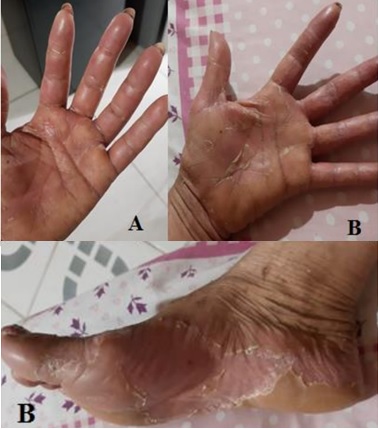Hand-foot syndrome after use of Doxorubicin
Main Article Content
Abstract
Hand-foot syndrome (HFS), also known as palmar-plantar erythrodysesthesia, is a dose-dependent cutaneous toxicity associated with numerous cytotoxic antineoplastic agents and some targeted therapies. Its incidence ranges from 6% to 64%, with capecitabine and pegylated liposomal doxorubicin being the most frequently implicated drugs. The pathogenesis combines direct cytotoxicity on keratinocytes and eccrine glands of the palms and soles, areas rich in microvasculature and subject to mechanical pressure. Clinically, it begins with dysesthesias that progress to well-defined erythema, edema, and scaling; CTCAE criteria help grade severity and determine dose adjustments. Management integrates prophylaxis (emollients, regional cooling) and symptomatic treatment with high-potency topical corticosteroids, analgesics, and keratolytics. Severe cases may require reduction or deferral of chemotherapy to preserve quality of life and therapeutic continuity
Article Details

This work is licensed under a Creative Commons Attribution 4.0 International License.
References
Bolognia JL, Cooper DL, Glusac EJ. Toxicery the maofchemotherapy: a useful clinical term. J Am Acad Dermatol. 2008;59(3):524-9. doi: 10.1016/j.jaad.2008.05.018.
Miller KK, Gorcey L, McLellan BN. Chemotherapy-induced hand-foot syndrome and nail changes: a review of clinical presentation, etiology, pathogenesis, and management J Am Dermatol. [Internet]. 2014;[citado 3 de julio de 2024]71(4):787-94. doi: 10.1016/j.jaad.2014.03.019.
McLellan B, Ciardiello F, Lacouture ME, Segaert S, Van Cutsem E. Regorafenib-associated hand-foot skin reaction: practical advice on diagnosis, prevention, and management. Ann Oncol. 2015;26(10):2017-26. doi: 10.1093/annonc/mdv244.
Kwakman JM, Elshot Y, Punt C, Koopman M. Management of cytotoxic chemotherapyinducedhand-foot síndrome. Oncol Rev.[Internet] 2020;[citado 25 de mayo de 2024] 14(1):442. doi: 10.4081/oncol.2020.442.
Braghiroli CS, Ieiri R, Ocanha JP, Paschoalini RB, Miot HA. Do you know this syndrome? Hand-foot syndrome. An Bras Dermatol. 2017;92(1):131-3. doi: 10.1590/abd1806-4841.20174602
Sanmartín O, Beato C, Suh-Oh HJ, Aragón I, España A, Majem M, et al. Manejo clínico de los eventos adversos cutáneos en pacientes tratados con quimioterapia: consenso nacional de la Academia Española de Dermatología y Venereología y de la Sociedad Española de Oncología Médica. Actas Dermosifiliogr. 2019;110(6):448-59.
Squeff M, Otal M, Boncompain C, Moreno C, Mercau S, Gorosito M. Eritrodisestesia o síndrome mano pie. Arch Argent Dermatol. 2016;66(6):169-172. Disponible en: https://www.archivosdermato.org.ar/wp-content/uploads/2019/09/169Squeff-Eritrodisestesia.pdf
Hueso L, Sanmartín O, Nagore E, Botella-Estrada R, Requera C, Llombart B, et al. Eritema acral inducido por quimioterapia: estudio clínico e histopatológico de 44 casos. Actas DermoSifiliográficas [Internet]. 2008;[citado 3 de julio de 2024]99:281-90. Disponible en: https://www.actasdermo.org/es-eritema-acral-inducido-por-quimioterapia-articuloS0001731008746775
Pandy JG, Franco PI, Li R. Prophylactic strategies for hand-foot syndrome/skin reaction associated with systemic cancer treatment: a meta-analysis of randomized controlled trials. Support Care Cancer. [Internet]. 2022;[citado 3 de julio de 2024]30(11):8655-8666. doi: 10.1007/s00520- 022-07175-3.
